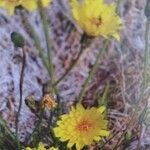A small herb. It is a dandelion like daisy. It grows 10-40 cm long and 5-30 cm wide. It keeps growing from year to year. It has tubers which are edible. The leaves are in a ring near the base. The leaves are 4-40 cm long by 0.2-2 cm wide. They are narrowly sword shaped but vary in shape. The leaves near the base can have teeth or lobes. The flower stalk is 10-40 cm long. It is unbranched and hollow. The flower heads are daisy-like. They are 2.5-5 cm across. The occur singly and are bright yellow. They are at the top of the plant. The fruit is dry and one seeded. It is 0.6-1 cm long.

